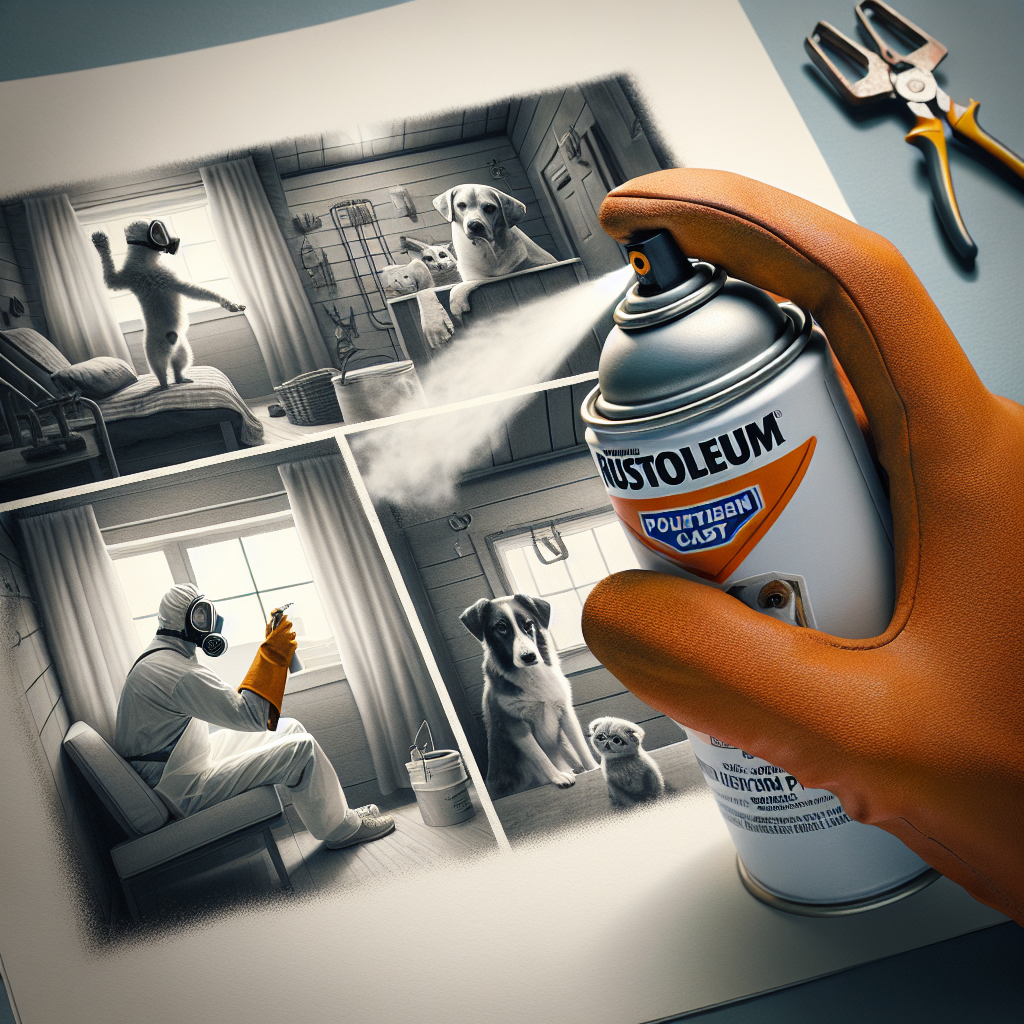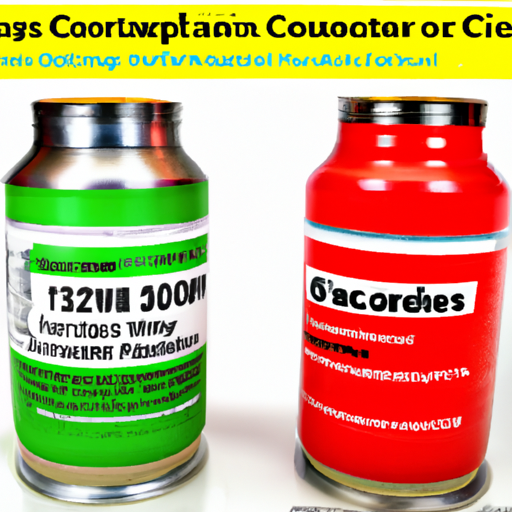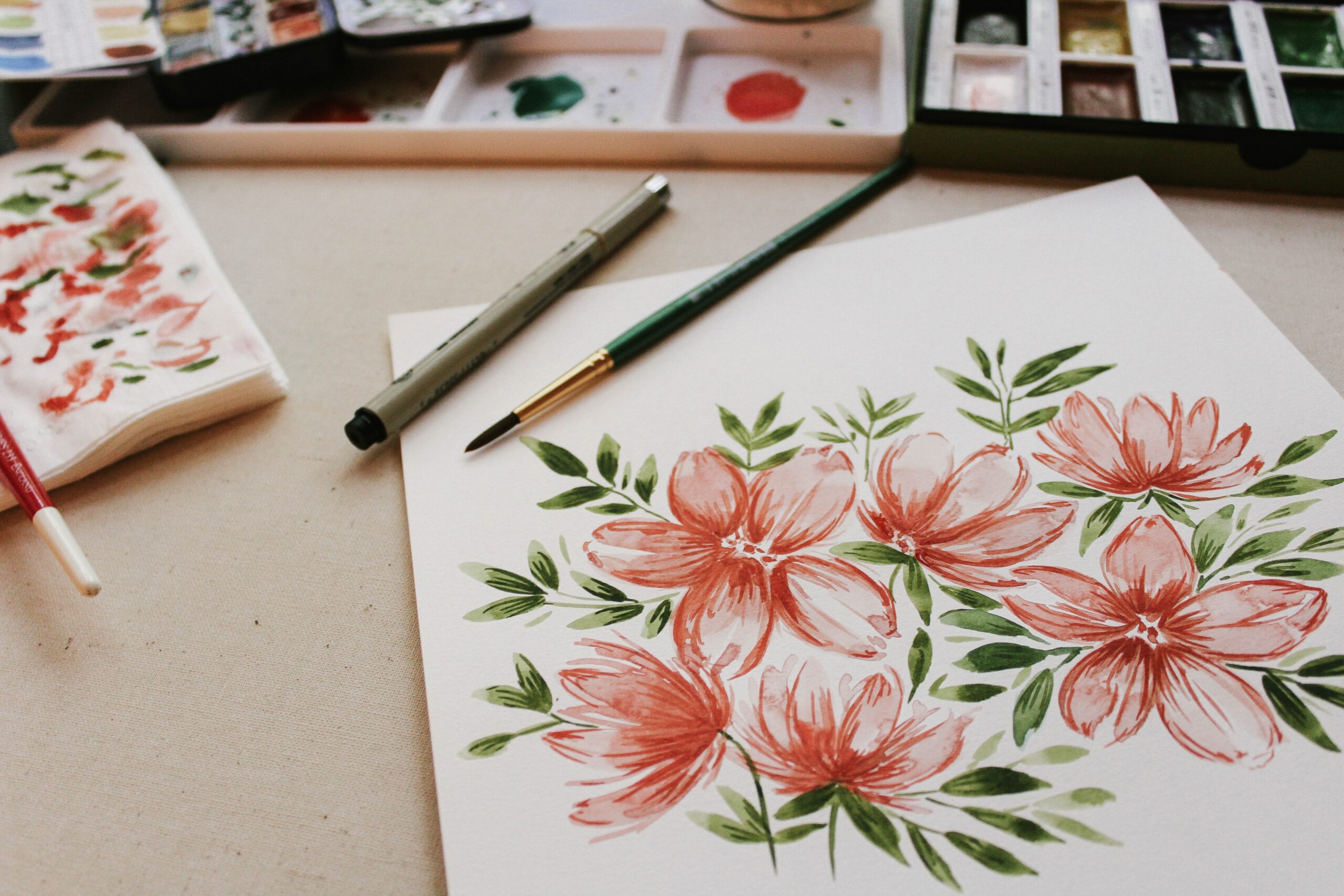As a responsible pet owner, it is crucial to ensure that every product we use around our furry companions is safe and non-toxic. One particular concern that arises when it comes to home improvement projects is the safety of spray paint, especially the popular brand Rustoleum. In this article, we will explore the potential hazards that Rustoleum spray paint might pose to our beloved pets, shedding light on the ingredients used, their effects on animals, and providing you with the necessary information to make an informed decision regarding the safety of using Rustoleum spray paint around your pets.
What is Rustoleum Spray Paint?
Rustoleum Spray Paint is a type of paint that is commonly used for various DIY projects. It is known for its quick-drying formula, ease of application, and durability. Rustoleum Spray Paint is available in a wide range of colors and finishes, making it a popular choice for both indoor and outdoor projects. Whether you are painting furniture, appliances, or even your car, Rustoleum Spray Paint offers a convenient and efficient way to achieve a professional-looking finish.
Description of Rustoleum Spray Paint
Rustoleum Spray Paint is a high-quality paint that comes in an aerosol can. It is formulated with a combination of pigments, solvents, and binders that allow for a smooth and even application. The paint particles are dispersed in a fine mist through the nozzle of the can, allowing for a controlled and precise painting experience. With Rustoleum Spray Paint, you can achieve a beautiful, long-lasting finish on a variety of surfaces, including wood, metal, plastic, and more.
Common uses of Rustoleum Spray Paint
Rustoleum Spray Paint can be used for a wide range of applications, both indoors and outdoors. Some common uses of Rustoleum Spray Paint include:
-
Furniture: Give your old furniture a fresh new look by using Rustoleum Spray Paint to update its color or finish. Whether it’s a wooden chair, a metal table, or a plastic dresser, Rustoleum Spray Paint can help transform your furniture and make it look brand new.
-
Home Decor: Add a pop of color to your living space by repainting accessories and decorative items with Rustoleum Spray Paint. From vases and picture frames to lamp bases and candle holders, the possibilities are endless when it comes to creating customized home decor pieces.
-
Automotive: If you want to give your car a makeover without the need for expensive bodywork, Rustoleum Spray Paint can be a great solution. Whether you want to change the color of your car or touch up small scratches and chips, Rustoleum Spray Paint offers a cost-effective way to achieve a professional-looking finish.
-
Outdoor Projects: Rustoleum Spray Paint is designed to withstand the elements, making it an excellent choice for outdoor projects. From painting metal patio furniture to refreshing the color of your front door, Rustoleum Spray Paint can help protect and beautify your outdoor surfaces.
Potential Dangers of Spray Paint for Pets
While Rustoleum Spray Paint can be a convenient and effective tool for DIY projects, it is important to be aware of the potential dangers it may pose to pets. Pets, such as dogs and cats, are curious creatures that can easily come into contact with spray paint if not properly supervised. Here are some potential dangers of spray paint for pets:
Toxic Ingredients in Rustoleum Spray Paint
Rustoleum Spray Paint contains various chemicals and solvents, some of which may be toxic to pets if ingested or inhaled. These toxic ingredients can cause a range of health issues, from mild irritation and allergies to more severe respiratory problems and organ damage. It is essential to familiarize yourself with the specific ingredients of Rustoleum Spray Paint and understand their potential risks to pets.
Inhalation Risks for Pets
One of the primary concerns when using spray paint around pets is the risk of inhalation. Pets that are in close proximity to spray paint fumes can experience respiratory distress, coughing, sneezing, and difficulty breathing. Prolonged exposure to these fumes can lead to more severe respiratory issues, such as bronchitis or pneumonia. It is crucial to take precautions to ensure that pets are not exposed to the direct inhalation of spray paint fumes.
Skin and Eye Irritation
Spray paint can also cause skin and eye irritation if it comes into contact with your pet’s fur, skin, or eyes. The chemicals present in the paint can cause redness, itching, swelling, and discomfort. In severe cases, prolonged exposure or contact with spray paint can lead to chemical burns or corneal damage. It is important to observe your pet for any signs of skin or eye irritation and seek veterinary care if necessary.
Ingestion Risks
Pets are naturally curious and may attempt to lick or chew on objects that have been recently painted with spray paint. Ingesting spray paint can have serious consequences for pets, as the toxic chemicals can cause gastrointestinal distress, including vomiting, diarrhea, and abdominal pain. In some cases, ingestion of spray paint can lead to more severe complications, such as liver or kidney damage. It is vital to prevent pets from accessing areas where recently painted objects may be present.

This image is property of images.unsplash.com.
Safety Precautions for Using Rustoleum Spray Paint around Pets
When using Rustoleum Spray Paint in a household with pets, it is essential to prioritize their safety and well-being. By taking the following safety precautions, you can minimize the risks associated with spray paint exposure for your furry friends:
Spray Paint in a Well-Ventilated Area
Ensure that you are using Rustoleum Spray Paint in a well-ventilated area. Open windows and doors to allow fresh air circulation, and consider using fans to help dissipate fumes faster. Adequate ventilation will help reduce the concentration of harmful chemicals in the air and lessen the risk of inhalation for both pets and humans.
Keep Pets Out of the Painting Area
To prevent pets from coming into direct contact with spray paint, it is crucial to keep them out of the painting area. Set up a safe and separate space for your pets away from the project area. This can be a designated room, a crate, or an outdoor enclosure, depending on the size and needs of your pet. Keeping pets at a safe distance will minimize their exposure to spray paint fumes and any potential hazards.
Protective Gear for Pet Owners
When using Rustoleum Spray Paint, it is advisable for pet owners to wear personal protective equipment (PPE) to minimize the risk of skin or respiratory contact with the paint. This includes wearing gloves, a respirator or mask, and protective eyewear. By protecting yourself, you can reduce the chances of inadvertently exposing your pets to spray paint residue on your skin or clothing.
Cover or Remove Pet-Accessible Items
Before starting a spray paint project, it is essential to cover or remove any pet-accessible items in the vicinity. This includes pet beds, toys, food bowls, and litter boxes. Covering these items with plastic sheets or moving them to a different room will prevent pets from accidentally coming into contact with freshly painted surfaces or paint particles.
Proper Cleanup and Storage
After completing your spray paint project, it is crucial to clean up any paint residue and properly store the cans. Wipe down surfaces with a damp cloth to remove any lingering paint particles and dispose of them in a sealed container or trash bag. Store any leftover spray paint cans in a secure location that is inaccessible to pets, such as a locked cabinet or storage shed.
Alternatives to Rustoleum Spray Paint for Pet-Friendly Projects
If you are concerned about the potential risks associated with Rustoleum Spray Paint and prefer to use pet-friendly alternatives for your DIY projects, there are several options to consider. Here are some alternatives to Rustoleum Spray Paint that are safe for pets:
Water-Based or Acrylic Paints
Water-based or acrylic paints are non-toxic and safe for pets when used as directed. These paints have a lower level of volatile organic compounds (VOCs) compared to traditional solvent-based paints, making them a safer choice for both humans and animals. Water-based or acrylic paints can be applied with a brush or roller and offer a similar range of colors and finishes as Rustoleum Spray Paint.
Non-Toxic Pet-Safe Spray Paints
Some manufacturers offer non-toxic spray paints specifically designed for use around pets. These pet-safe spray paints are formulated with ingredients that are safe for animals, eliminating the risk of toxic exposure. They come in a variety of colors and finishes and can be used for a wide range of DIY projects, from furniture refinishing to crafts and artwork.
Natural Dyes or Food Coloring
For certain decorative projects, natural dyes or food coloring can be a safe and non-toxic alternative to spray paint. These dyes are made from organic materials and do not contain harmful chemicals. They can be used to add color to fabrics, paper, and other materials, providing a pet-friendly way to create vibrant and unique designs.
Other Pet-Friendly Decorative Options
In addition to using paints, there are numerous pet-friendly decorative options available for DIY projects. Consider using fabric, washi tape, removable decals, or vinyl stickers to add patterns and colors to your furniture, walls, or other surfaces. These options allow for easy customization and can be easily removed or changed without causing permanent damage.

This image is property of images.unsplash.com.
Consulting a Veterinarian
If you suspect that your pet has been exposed to spray paint or is showing signs of illness or distress after being around spray paint, it is important to consult a veterinarian. A veterinarian can provide professional advice and guidance based on your pet’s specific situation. Here are some guidelines on when to consult a veterinarian and what symptoms to watch for:
When to Consult a Veterinarian
You should consult a veterinarian if you notice any of the following signs or symptoms in your pet after being exposed to spray paint:
- Difficulty breathing or rapid breathing
- Coughing or wheezing
- Excessive drooling or foaming at the mouth
- Vomiting or diarrhea
- Lethargy or weakness
- Skin redness, swelling, or irritation
- Eye redness, discharge, or squinting
Symptoms to Watch for in Pets Exposed to Spray Paint
Pets may exhibit various symptoms after being exposed to spray paint. These symptoms can range from mild irritation to severe respiratory distress. It is important to monitor your pet for any signs of illness or discomfort and seek veterinary attention if necessary. Common symptoms to watch for in pets exposed to spray paint include:
- Sneezing or nasal discharge
- Eye irritation or redness
- Coughing or gagging
- Difficulty breathing or rapid breathing
- Vomiting or diarrhea
- Lethargy or weakness
Safe Steps to Take if Your Pet is Affected
If you suspect that your pet has been affected by spray paint exposure, there are several safe steps you can take before seeking veterinary care:
- Remove your pet from the area of exposure and bring them to a well-ventilated space.
- Rinse any affected areas, such as the eyes or fur, with clean water to remove any residual paint or irritants.
- Monitor your pet closely for any changes in behavior or symptoms.
- Contact your veterinarian for further advice and guidance on how to proceed.
Pet-Safe Alternatives to Rustoleum Products
If you prefer to stick with Rustoleum products for your DIY projects but want to ensure their safety for your pets, there are pet-safe alternatives available. Rustoleum offers a range of products that are specifically labeled as safe for pets, providing peace of mind for pet owners.
Rustoleum Products Specifically Labeled as Safe for Pets
Certain Rustoleum products are specially formulated and labeled as safe for use around pets. These products undergo rigorous testing to ensure that they do not contain toxic ingredients and are safe for both humans and animals. When selecting Rustoleum products, look for the ones that are specifically labeled as pet-safe to ensure the highest level of safety for your pets.
Researching Pet-Safe Brands
In addition to Rustoleum, there are other reputable brands that offer pet-safe paints and coatings for DIY projects. Researching and identifying these brands can help you find alternative options that meet your needs while prioritizing the safety of your pets. Look for brands that clearly state their commitment to pet safety and provide detailed information about their product ingredients and testing processes.
Checking Material Safety Data Sheets (MSDS)
When considering any paint or coating product, it is important to review the Material Safety Data Sheet (MSDS) for detailed information about its ingredients and potential hazards. The MSDS provides essential safety information and can help you determine whether a product is safe for use around pets. It is advisable to choose products that have transparent and easily accessible MSDSs, as this demonstrates the manufacturer’s commitment to safety and transparency.

This image is property of images.unsplash.com.
Other Potential Household Hazards for Pets
While spray paint is a potential hazard for pets, it is just one of many household products that can pose a risk. As responsible pet owners, it is crucial to be aware of other potential hazards in our homes and take steps to mitigate these risks. Here are some common household products and situations that can be toxic to pets:
Common Household Products Toxic to Pets
-
Cleaning Products: Many household cleaning products, such as bleach, laundry detergents, and disinfectants, contain chemicals that are toxic to pets if ingested or inhaled. Always store these products out of reach and use pet-safe alternatives when possible.
-
Medications: Prescription medications and over-the-counter drugs can be extremely dangerous for pets. Keep all medications securely stored and never administer human medications to your pets without veterinary guidance.
-
Plants: Some indoor and outdoor plants can be toxic to pets if ingested. Examples include lilies, azaleas, tulips, and certain types of ivy. Research plant toxicity before bringing new plants into your home or garden.
Painting and Home Improvement Risks for Pets
Home improvement projects, including painting, can pose hazards to pets beyond spray paint exposure. Other risks associated with painting and home improvement projects include:
-
Tripping Hazards: Pets may be curious about tools, paint cans, and other materials left out during projects, leading to potential tripping hazards for both humans and animals. Keep project areas clean and organized, and ensure that tools and materials are stored safely when not in use.
-
Electrical Hazards: During home improvement projects, electrical cords and outlets may be exposed. Pets may chew on cords or come into contact with live wires, leading to electrical shock or injury. Keep pets away from project areas and ensure that all electrical work is done by a qualified professional.
Securing Hazardous Materials
To create a safe environment for your pets, it is important to secure and properly store hazardous materials in your home. This includes chemicals, paints, cleaning products, medications, and other potentially toxic substances. Store these items in locked cabinets or high shelves that are inaccessible to pets. Additionally, properly dispose of any hazardous waste according to local regulations to prevent accidental exposure to pets or wildlife.
Creating Pet-Friendly Environments
Creating a pet-friendly environment in your home involves taking proactive steps to ensure the safety and well-being of your pets. When it comes to paint and coatings, there are several considerations to keep in mind to create a pet-friendly space:
Designing Pet-Safe Spaces in Your Home
Designating pet-safe spaces in your home is a great way to provide your pets with a safe and comfortable area to relax and play. When planning these spaces, consider the type of finishes and materials you use. Opt for non-toxic paints and coatings, pet-friendly flooring, and durable furniture that can withstand your pet’s activities.
Pet-Proofing Areas with Paint or Coatings
In areas where pets may spend a significant amount of time, such as the kitchen or living room, pet-proofing the surfaces with appropriate paints or coatings can be beneficial. Look for pet-safe or eco-friendly paints that are easy to clean and resistant to scratches and stains. These coatings can help protect your walls, floors, and furniture from pet-related wear and tear.
Consideration for Pet Fur and Claws
Pets, especially cats and dogs, can shed fur and have sharp claws that can cause damage to surfaces over time. When selecting paint or coatings, consider their durability and resistance to scratching. Opt for finishes that are easy to clean and maintain, minimizing the accumulation of pet hair and making it easier to remove any accidental scratches or marks.

Educating Pet Owners
Educating pet owners about the potential dangers of spray paint and other household hazards is crucial for the well-being of pets. By raising awareness and providing information on pet-safe alternatives and precautions, we can ensure that pet owners make informed choices and prioritize the safety of their furry friends.
Educational Resources on Pet Safety
There are numerous educational resources available that provide information on pet safety and the potential hazards of household products. Pet owners can access articles, guides, and videos from reputable sources such as veterinary clinics, animal welfare organizations, and pet care websites. These resources provide valuable information on a wide range of topics, including pet-friendly paints and coatings.
Importance of Awareness and Precautions
By raising awareness about the potential dangers of spray paint and other household hazards, pet owners can make better choices to protect their pets. Understanding the risks and taking appropriate precautions can greatly reduce the likelihood of accidental exposures and associated health issues. It is important for pet owners to prioritize the safety of their pets and be proactive in creating a pet-friendly environment.
Sharing Pet-Safe Alternatives and Tips
Sharing information about pet-safe alternatives and tips can help pet owners make informed decisions when it comes to their DIY projects. By discussing and recommending pet-friendly paints, coatings, and other decorative options, we can encourage responsible choices that prioritize the well-being of our pets. Sharing personal experiences, tips, and recommendations within pet owner communities can be a valuable resource for those seeking pet-safe solutions.
Conclusion
While Rustoleum Spray Paint is a popular choice for DIY projects, it is important to be aware of the potential dangers it may pose to pets. The toxic ingredients and fumes associated with spray paint can harm pets if not used and stored properly. By taking safety precautions, such as using spray paint in well-ventilated areas, keeping pets away from the painting area, and using protective gear, pet owners can minimize the risks. Additionally, there are pet-friendly alternatives to Rustoleum Spray Paint, such as water-based or acrylic paints, non-toxic pet-safe spray paints, and natural dyes or food coloring. Pet owners should always consult a veterinarian if their pet is exposed to spray paint and shows signs of illness or distress. It is important to create pet-friendly environments in our homes and educate ourselves and other pet owners about potential household hazards. By prioritizing awareness, precautions, and pet-safe alternatives, we can ensure the safety and well-being of our beloved furry companions.




